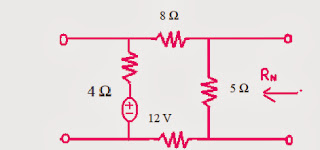Thevenin's Theorem states that any network of voltage sources and resistors can be reduced to a single voltage source and a single resistor which are in SERIES with each other.
thevenin's theorem is to let you simplify the complicated circuit. So to make it, we need to what it is.
In solving thenenin's theorem we have to fine first the equivalent voltage Vth and the resistance Rth. lets solve some problem to understand it better.
Find the thevenin'n equivalent circuit shown.
Rth= 4 // 12 + 1= 4 ohms
to find Vth let us apply the mesh analysis to the two loops..
solving for I1 we get 0.5 A
this circuit contains no dependent source. Just remember to solve this kind of circuit you get first the Rth and Rth and the remaining will follow. If you will encounter circuits that has dependent source leave it on the circuit and kill all dependent source and assume voltage source to the circuit where you are required to get.
Norton's Theorem
Norton's Theorem states that
it is possible to simplify any linear circuit, no matter how complex, to an
equivalent circuit with just a single current source and parallel resistance
connected to a load.
You will determine if what kind to theorem you are going to use, we already know what thevenin's theorem has
Let's take a look of some example:
The same as thevenin's theorem, we get Rn by setting all independent source into zero.
To find Rn we will short circuit terminals a and b and ignore 5 ohms resistor because it has been shorted. applying mesh we can get.
we obtain
Maximum Power Transfer
states that to obtain maximum power from a source with a fixed internal resistance the resistance of the load must be made the same as that of the source.
Therefore we conclude that RL = Rth
To obtain maximum power transferred











No comments:
Post a Comment